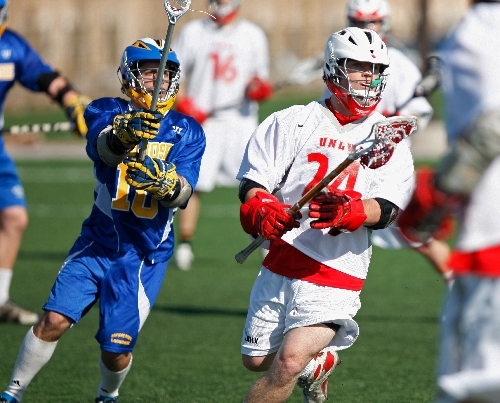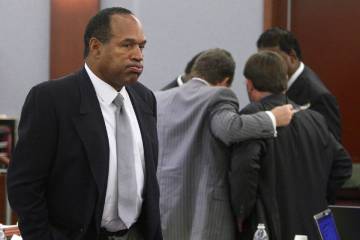UNLV club sports thrive without the backing varsity teams get
Decked out in scarlet and gray with "Hey Reb" logos adorning their uniforms, they look like Rebels.
They attend class and have to make grades like the Rebels.
They travel to compete same as the Rebels.
They skate, pass, shoot, rope, ride, jab, scrum and run like Rebels.
They are indeed real Rebels.
For hundreds of men and women, the club sports program at the University of Nevada, Las Vegas is a way to keep playing the game they love while at the same time representing the Rebels. While UNLV fully funds 17 varsity
sports and offers scholarships for many of those athletes, many participants in the school's 17 club teams have to pay if they want to play.
And they do so in relative anonymity.
These athletes have to make grades to be eligible, just like the varsity teams. While the NCAA doesn't legislate academics on the club level, the teams themselves and the leagues they compete in mandate that athletes maintain a 2.0 grade-point average while taking at least 12 hours of classes.
"I just love the game, and I love all the guys," said John Beavers, a 5-foot-5-inch junior forward on UNLV's ice hockey team. "To represent the school and Vegas is a bonus."
Over the years, the clubs have represented UNLV well. The boxing and rodeo teams have won national championships. The bowling, rugby, ice hockey and roller hockey teams have competed in national tournaments. The powerlifting team has had individual national champions.
"I definitely feel like I'm more a part of the school," rugby player Jay Cassidy said.
Their love for the game doesn't come cheap. Ice hockey team members have to pay $2,100 during the season to compete. Rodeo team members have to pay between $400 and $500 to enter each of their 10 events. The cost to play men's lacrosse: $1,500 for the spring semester.
According to Blake Simpfenderfer, UNLV's coordinator for Sports Clubs, the school provides up to $500 for club activities and another $1,000 for travel. But the funding is on a first-come, first-served basis and must be approved by student government. Simpfenderfer said that all teams that fill out the necessary paperwork are ultimately approved.
For a program such as ice hockey, which has a budget of approximately $100,000, that amount wouldn't buy a pair of goalie pads. Clubs rely on the community for support. And given the state of the local economy, the challenge of finding money is daunting.
"Our donations are down considerably from where they've been," said Rob Pallin, UNLV's ice hockey coach whose big budget includes buying ice time at the Sobe Ice Arena at the Fiesta for practice and games, travel to competitions and for officials and equipment. "We used to see donations of $20,000, $25,000. We didn't get that this year."
UNLV's boxing team, which has competed at a high level since its inception in 1998, is barely hanging on financially. Coach Frank Slaughter said if things don't improve, he's not sure whether UNLV's boxing team will survive.
"We're surviving by the skin of our teeth," he said. "We need new equipment. The coaches are unpaid. We haven't been able to host a tournament because we don't have the money to bring the teams in.
"We're supposed to be the boxing capital of the world, but nobody wants to help these kids? I don't understand it."
Rugby, which has been around at UNLV since 1991 and has been to the USA Rugby intercollegiate national tournament twice (in 1999 and 2000), has made itself an attractive alternative to athletes who don't want to play football, soccer or lacrosse but want to engage in a physical sport.
"I've made friends through rugby that I'll have for life," said senior Eric Dutcher, who played high school football in Elko but found rugby more to his liking in college. "What other sport can you spend three hours trying to kill each other, and then after it's over, sit down and have a beer with each other?"
The lack of public visibility is another dilemma facing UNLV clubs. Unlike varsity sports, which are serviced by the school's sports information office, the clubs have to do their own public relations.
The most common refrain heard by club members is: "I didn't know UNLV had a (fill in the blank) team."
Because regular coverage in traditional media such as newspapers, television and radio is virtually nonexistent, most of the clubs rely on social networking. Through Facebook and Twitter along with team Web sites, students and fans can follow the various teams.
"It definitely helps," men's lacrosse club president Mark Day said of using Facebook. "But mostly, it's word-of-mouth. That's how we usually let people know we're playing."
Several of the clubs compete in leagues, just like UNLV's varsity sports. Hockey plays in the American Collegiate Hockey Association and competes with club teams from Arizona, Arizona State, UCLA, Brigham Young, San Diego State and San Jose State. Lacrosse plays in the Southwestern Lacrosse Conference and has faced UCLA, San Jose State, Gonzaga, Montana and San Diego.
"The varsity athletes think it's pretty cool," Day said. "I was in a class last year with (basketball player) Chace Stanback, and when I told him I played on the lacrosse team, he said he was going to check us out.
"B.J. Bell of the football team has been to some of our games and so have a few other football players. It's nice to get that kind of support from the higher-profile athletes on campus. It means a lot to us because we feel we're as much a part of UNLV athletics as they are, even though we're just a club."
Orie Lemmons, a senior rodeo team member, said he shocked his world literature professor when he wrote in his journal about competing for UNLV as a cowboy.
"He wrote on the paper, 'Never knew we had a rodeo team,'" Lemmons said. "I get that a lot when I tell people about what I do."
He also got an A on his paper.
Contact reporter Steve Carp at scarp@reviewjournal.com or 702-387-2913.
View the slideshow
unlv CLUB SPORTS
List of club sports at UNLV:
Bowling
Boxing
Competitive Dance
Cycling
Dance Sport
Flag Football
Ice Hockey
Men's Lacrosse
Women's Lacrosse
Powerlifting
Racquetball
Rodeo
Roller Hockey
Men's Rugby
Women's Rugby
Ultimate Frisbee
Men's Volleyball


















